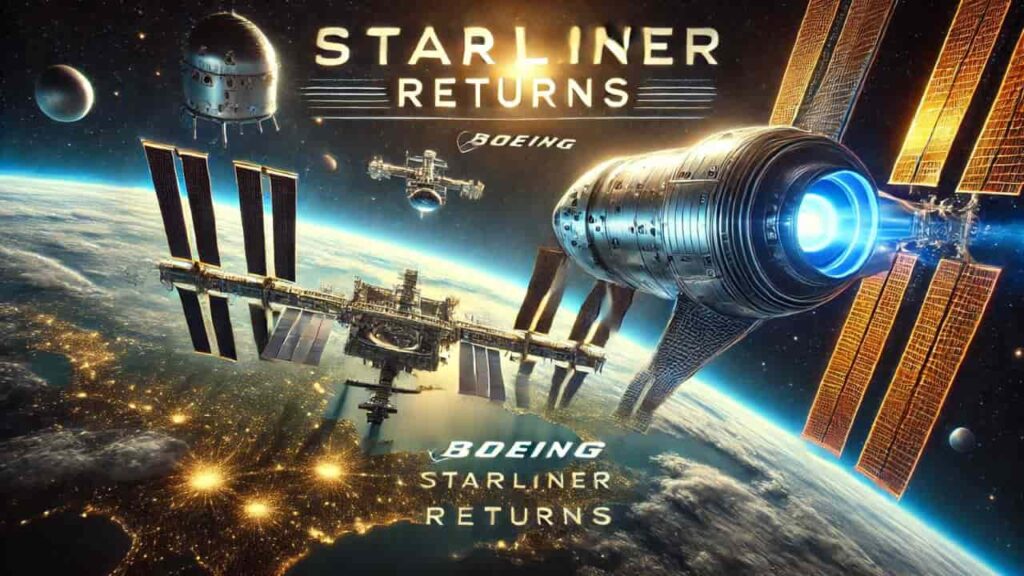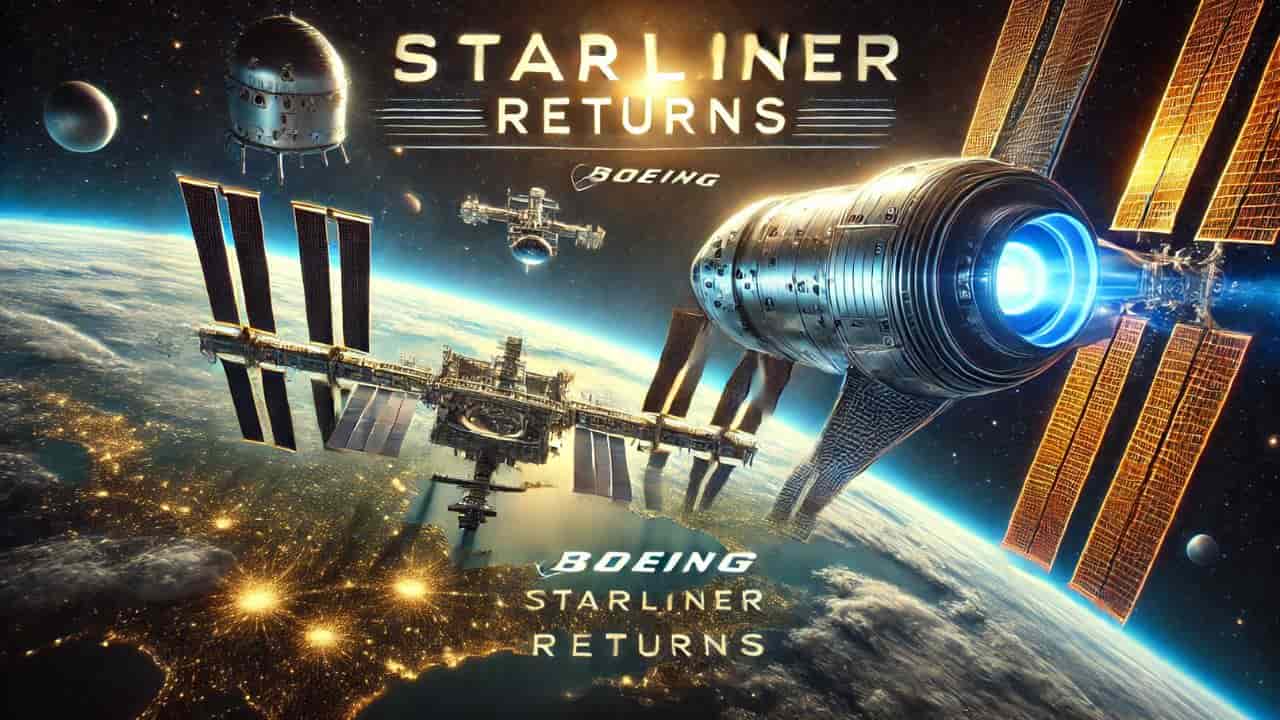Boeing Starliner, Starliner spacecraft, NASA Starliner return, Commercial Crew Program, Starliner undocking, ISS spacecraft return, NASA Boeing collaboration, uncrewed spacecraft, space exploration, Starliner landing, ISS docking issues
Boeing’s Starliner spacecraft undocked from the ISS and began its journey back to Earth without astronauts. Learn about the challenges faced by Starliner, its role in NASA’s Commercial Crew Program, and how Boeing is addressing technical issues to ensure a successful future for the spacecraft.

Boeing’s Starliner Spacecraft: A Journey Home Without Astronauts
On Friday, September 6th, 2024, Boeing’s Starliner spacecraft undocked from the International Space Station (ISS), embarking on a crucial return voyage to Earth. However, unlike its previous missions, this journey is uncrewed, marking another pivotal moment in the history of space exploration and Boeing’s involvement in NASA’s Commercial Crew Program. This event showcases the ongoing collaboration between NASA and Boeing as they test and develop systems capable of sending astronauts to space on a regular basis.
The Moment of Undocking: A Key Milestone
At precisely 6:04 p.m. EST on that fateful Friday, the Starliner disengaged from the ISS, initiating its solo return journey to Earth. The undocking event was broadcast live by NASA, allowing the world to witness this milestone in real-time. As the spacecraft cleared the ISS, the live commentary announced, “OK, she’s on her way home,” capturing the excitement and significance of the event.
The spacecraft is scheduled to land at White Sands Space Harbor in New Mexico at around 12:03 a.m. EST on Saturday, September 7th. A news conference with NASA and Boeing officials will follow the landing, where they will discuss the success of the mission and what it means for the future of space travel.
Starliner’s First Crewed Mission: Astronauts Wilmore and Williams
Boeing’s Starliner has had a complex journey, both before and after this undocking event. On June 5th, 2024, NASA astronauts Barry “Butch” Wilmore and Sunita “Suni” Williams embarked on the Starliner’s first-ever crewed test flight. The initial mission plan was for a week-long stay in space, testing the spacecraft’s capabilities while docked at the ISS.
However, several unexpected challenges arose during the mission, forcing NASA to alter its plans. Although the Starliner successfully docked with the ISS, the issues it encountered prompted NASA to reschedule the astronauts’ return. Instead of returning aboard the Starliner as initially intended, Wilmore and Williams will now return in February 2025 aboard SpaceX’s Crew-9 Dragon spacecraft.
Despite the unexpected delays, the astronauts played a crucial role in preparing Starliner for its return journey. They reconfigured the spacecraft’s seats for an uncrewed landing and packed it with cargo for retrieval by ground crews upon its return to Earth. Additionally, they returned important emergency hardware stowed inside the Starliner to the ISS, ensuring that future missions would have access to these essential supplies.
NASA’s Commercial Crew Program: Starliner’s Role
Boeing’s Starliner is an integral part of NASA’s Commercial Crew Program, a bold initiative aimed at certifying private spacecraft for routine missions to and from the ISS. The program’s ultimate goal is to increase the frequency of human spaceflights and reduce the costs associated with these missions, paving the way for future exploration. NASA’s collaboration with Boeing is a key component of this mission, and Starliner’s successful certification would mark a significant achievement for both organizations.
Despite the technical challenges faced by the spacecraft, NASA and Boeing officials have expressed confidence in Starliner’s ability to return safely to Earth. During a news conference on the Wednesday before the undocking, Steve Stich, the program manager for NASA’s Commercial Crew Program, stated, “We have confidence in the vehicle… We’ve had two good landings so far, and we’re expecting another one on Friday.”
The Bumps on Starliner’s Road: Pre-Launch Delays
The development of Boeing’s Starliner has not been without its hurdles. The spacecraft’s initial flight test was originally scheduled for May 6th, 2024. However, an issue with an oxygen valve on a rocket manufactured by United Launch Alliance (ULA) forced NASA and Boeing to scrub the mission. ULA, a prominent manufacturer and operator of rockets, is responsible for launching spacecraft into orbit.
A new launch date was subsequently set for May 25th, but the mission was delayed once again after a small helium leak was detected in the spacecraft’s service module. This module contains essential support systems and instruments for operating the spacecraft, and the leak required immediate attention. The delay pushed the launch back to June 5th, when the Starliner finally lifted off successfully.
Even after launch, Starliner encountered additional technical issues. The spacecraft experienced a thruster malfunction, along with several small helium leaks, which threatened to delay its docking at the ISS. Fortunately, engineers were able to troubleshoot these issues, allowing the spacecraft to dock with the ISS on June 6th, just one day after its scheduled arrival.
Mid-Mission Challenges: Helium Leaks and Ground Tests
After Starliner successfully docked at the ISS, NASA and Boeing revealed that the spacecraft had developed five small helium leaks. Although the leaks were relatively minor, they still posed potential risks for the spacecraft’s return journey. However, engineers were able to determine that the spacecraft still had enough helium to complete its mission safely.
To further ensure the Starliner’s readiness for its return journey, NASA teams at the White Sands Test Facility in New Mexico conducted ground tests on the spacecraft’s thruster system. These tests simulated the conditions the spacecraft would encounter during its undocking from the ISS, providing engineers with valuable insights into how the thrusters would perform under pressure.
The results of these tests were reassuring, and NASA and Boeing proceeded with confidence in Starliner’s ability to undock from the ISS and begin its journey back to Earth.
The Future of Starliner: Boeing’s Vision for Space Travel
Boeing’s Starliner is a critical component of NASA’s future space exploration plans, especially within the framework of the Commercial Crew Program. Although SpaceX’s Crew Dragon spacecraft has already proven itself capable of ferrying astronauts to and from the ISS, the Starliner offers NASA another option, reducing its reliance on a single company for manned spaceflights.
Having two certified spacecraft—SpaceX’s Crew Dragon and Boeing’s Starliner—gives NASA much-needed flexibility and redundancy, ensuring that human spaceflights can continue even in the event of technical difficulties with one of the spacecraft. This redundancy is particularly important as NASA looks to maintain a continuous human presence on the ISS, and in the long term, expand its ambitions to include missions to the Moon, Mars, and beyond.
While Starliner’s journey has been far from smooth, the lessons learned from its development have been invaluable. Boeing’s engineers have gained critical insights into the spacecraft’s systems, enabling them to improve its performance and reliability. These improvements will be crucial as Boeing works to ensure that Starliner can perform regular missions to and from the ISS.
Learning from Challenges: The Importance of Testing and Redundancy
The development of Boeing’s Starliner has underscored the importance of rigorous testing and redundancy in space exploration. The spacecraft’s technical issues, including helium leaks and thruster malfunctions, could have had far more serious consequences if not identified and addressed early in the mission. The ground tests conducted by NASA and Boeing engineers at the White Sands Test Facility were a crucial part of ensuring the spacecraft’s safe return to Earth.
Moreover, Starliner’s challenges have highlighted the complexity of modern spacecraft. With thousands of interconnected systems working in tandem, even a small issue, like a helium leak, can pose a significant risk to the entire mission. The need for continuous monitoring, testing, and improvement cannot be overstated when it comes to building spacecraft capable of carrying humans safely into space.
Conclusion: A New Chapter in Space Exploration
Boeing’s Starliner spacecraft represents a significant achievement for both Boeing and NASA, even as it continues to face challenges on its path to certification. The spacecraft’s successful undocking from the ISS and its safe return to Earth will mark another important milestone in the Commercial Crew Program, bringing NASA one step closer to having multiple certified spacecraft capable of regular missions to the ISS.
With each mission, Boeing moves closer to realizing its vision of making space travel more accessible and routine. Starliner’s ability to overcome its technical challenges and safely return to Earth is a testament to the resilience and determination of the engineers and scientists working behind the scenes.
As NASA and Boeing continue to refine Starliner’s systems and prepare for future manned missions, the spacecraft will undoubtedly play a crucial role in the future of space exploration. Whether it’s ferrying astronauts to the ISS or helping to pave the way for missions to Mars, Boeing’s Starliner is poised to become a mainstay in NASA’s space exploration efforts for years to come.
Read More
